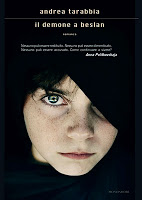By Veronica Frigeni

A story of wind and mud, blood and revenge, in the narrator’s own words, is the one, at the same time, recounted by and about the demon, i.e. that dismembered subject turned into agent of violence.
For the reader who engages with this novel for the first time it is quite unavoidably the overwhelming subject of the narration to monopolize his attention, thoughts and emotional response.
For the critic, instead, it is –it should be – the discursive strategy that Tarabbia adopts and unfolds throughout the text that eventually delimits the fundamental perimeter of any theoretical analysis.
Parallel to the dichotomy between guilty and innocence, blind evil and legitimacy, the novel articulates what is both a dyscrasia and an overlapping: that between the locator and the protagonist of the story.
A narrative that functions precisely at the threshold between enunciation and utterance. It is here, in effect, that the atrocity of the real leads to a symbolic or, better, to a sort of expressionist realism. Yet, probably, in this case, it is more the other way round. What I’m suggesting is that it is only through extending literary realism to its limits that a possible and legitimate approach to the upsetting reality of the event is allowed. An approach transcending the historical realism, gesturing towards what might be defined as a literary, namely universal truth.
Michael Rothberg coined the category of ‘traumatic realism’ in order to define all those devices and narratives that necessarily redefine and, in a sense, transcends the traditional conceptualization of realism. Paraphrasing Lacan, we might argue that when the Real breaks into reality, any pre-existing modality of Symbolic containment, i.e. of narration, collapses.
Traumatic realism develops out of and in response to the demand for documentation that an extreme historical event poses to those who would seek to understand it. “Documentation” consists of two elements — reference and narrative — that correspond to its nominal and verbal meanings. On the one hand, the demand for documentation calls for an archive of facts or details referring to the event. On the other hand, the active sense of documentation indicates the need for the construction of a realistic narrative that would shape those details into a coherent story. […] Traumatic realist texts, however, search for a form of documentation beyond direct reference and coherent narrative but do not fully abandon the possibility for some kind of reference and some kind of narrative.
Likewise Sue Vice argues that the same typical components of a novel, in fact, when integrated within a trauma fiction are ‘brought to their limit, taken literally, defamiliarized or used self-consciously’. Accordingly, in Marat’s confession and hallucinatory chronicle of the terroristic attack to the school in Beslan, we find exemplar principles of a mnemonic and traumatic rhetorical construction, such as intertextuality and repetition. Intertextuality operates as a mnemonic pointer, whose aim is to amplify the layer of truth within a literary narrative, whereas repetition signals more a working through, a psychological proceeding that reaches its climax in the confrontation with the priest. Repetition, truly, blends raw facts and subjective, imaginary projections, engendering a plurality of temporal strata and voices. ‘This is how it begins’, for instance, obsessively repeated in the first, eponym chapter, succeeds in delineating the historical aetiology of the attack. Nevertheless, it also creates an inner rhythm and rationale of justification rather than of justice.
Moreover, there are several idiosyncratic images that punctuate Andrea Tarabbia’s novel Il Demone a Beslan and orchestrate the level of the discourse. I intend to specifically mention three of them: the stone amphitheatre, the lamp and the head of a pitchfork.
The amphitheatre inaugurates the rhetoric and the practices of violence, yet rendering it suspended between reality and the illusion of a performance. In a sort of derealisation that prefigures or, at least, warns the reader about the opacity and the artificiality of a fictional confession.
The second element, the bulb named ‘mumu’, in its piercing light, in its being always functioning, resembles at once the disciplinary eye of the Panopticon as well as the inner gaze of conscience. An excess of luminosity that finds its counterpart in the gaze of the blind woman, chosen to be the judge, the ultimate executor of the terrorist attack, precisely because her eyes cannot see.
The third element, reminder of an epic epithet, is that of the head of the pitchfork. Which becomes both a synecdoche for the main character and narrator Marat, and a prosopopeia, the face of the absence of those who have died qua victims. If death is the theme, it implies, in my view, through its discursive transposition, an idea of absence even more powerful than that of evil.
In conclusion, therefore, I think that, reversing a gesture performed by the most part of the critics, the question to posit, when dealing with this novel, should be no longer ‘who is the demon’, rather ‘what are the conditions of possibility and the rationale of his discourse?’

Recent Comments